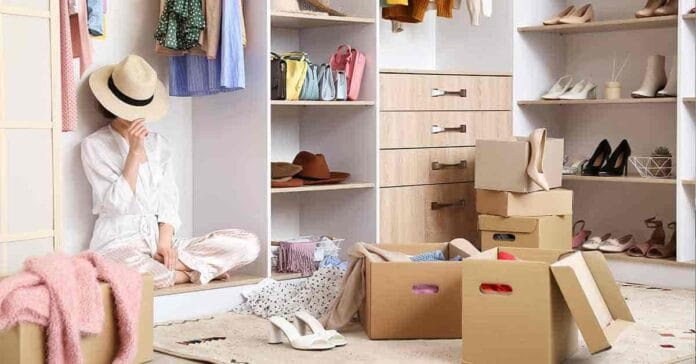Decluttering your wardrobe is key to achieving a more organized and stress-free closet. Start by removing items you no longer wear. This simple step can make a big difference. During relocation, consider using box storage or self storage to keep your clothes safe and organized. This helps free up space in your closet and makes the moving process smoother.
Utility lockers are also a great option for storing seasonal clothing or accessories, keeping them out of your daily way. By decluttering regularly, you create more space, making it easier to find what you need each morning. An organized wardrobe not only simplifies your daily routine but also gives you a sense of control and calmness.
Decluttering Wardrobes – Why is it Important?
Decluttering your wardrobe is important for several reasons. First, it helps you save time each morning by making it easier to find what you need. An organized closet reduces the stress of sifting through clothes you don’t wear. Decluttering also frees up space, allowing you to better see and appreciate the clothes you love. It can even reveal items you forgot you had!
Regularly sorting through your wardrobe encourages mindful shopping, preventing you from accumulating unnecessary items. Additionally, donating clothes you no longer wear benefits others and contributes to sustainability. Overall, a decluttered wardrobe promotes a more organized, efficient, and enjoyable daily routine, making your life simpler and more focused.
1. Start the Process with Questions
It is important to begin the decluttering process by asking yourself the following questions about each item in the closet:
- Do I like it?
- Do I wear it often?
- Does it match my current personality?
- Is the material comfortable?
- Is it pinching my toes? Is it possible to walk in these heels?
- Is it old or smelly or stained?
- Is it beyond repair?
Be a harsh critic. If necessary, enlist the help of a friend or family member to tell you if something is not right for you. Because closet space is limited, do not waste it on something you do not love.
2. Donate, Throw Away or Repurpose
As we grow, we also start to outgrow certain clothing, shoes or accessories items. To ensure that you do not have clothing that no longer fits or compliments your style, you must try them on first. Then you can start by separating the clothing stacks – ones you intend to keep, one you intend to donate, and one that is too old and worn to be used. Put the ones you are giving away in a box and distribute them as soon as possible. Those thrown away must be placed in trash bags and disposed of. Get organizers and hangers to help arrange your remaining clothes in a way that looks good and is also easy to track eventually.
Make it easier to declutter your wardrobe by keeping a donation bin, bag, or basket in your closet always if possible. This allows you to declutter your closet and discard items you no longer want as you come across them.
3. Go Through your Seasonal Clothes
A resident of Delhi is quite often known to own a few coats, warm socks, and other winter wear to brace for the colder months. These clothes do not need to be in your closet all year round. The best way to save space and make sure you are not hoarding clothes is to place them in a self-storage. You can make the most of your wardrobe space by making sure the clothes you do not wear, such as woolly sweaters do not remain hanging in your closet all year round! It is also encouraged to go through your winter wear ahead of the season to ensure the clothes fit right and if they do not add them to your donation basket.
4. Declutter your Closet regularly
If you want to be ruthless when decluttering your wardrobe, declutter it often. You will be willing and able to let go of a little more each time you declutter.
Not only will you prove to yourself that having a smaller, simplified wardrobe has advantages and makes life easier, but it will also help you declutter more. However, realizing that you do not miss any of the clothes you got rid of may encourage you to get rid of even more.
Decluttering your home can be a tiring business but once it is done you will feel an undeniable sense of peace. Make your living space a clutter-free zone and see how much better life is.
5. Use Professional Organizers
Professional organizers and decluttering experts are becoming increasingly popular worldwide, particularly in the aftermath of the pandemic and lockdowns, which caused people to spend more time at home. Professional organizers help clients tidy their homes while talking them through the process via video calls.
Professionals can help you tackle your closet and other areas of your home. Prachi Chowla, a former chartered accountant, founded Smiling Spaces, a Bengaluru-based decluttering and organizing service. Gayatri Gandhi, the founder of Joy Factory and the first certified KonMari Consultant in India, is among the professionals who can help start your decluttering journey.
Final Words for Decluttering Wardrobes
By organizing your closet, you save time, reduce stress, and make it easier to choose outfits each day. Decluttering also creates more space, allowing you to fully enjoy and use the clothes you love while letting go of what no longer serves you. This process encourages mindful shopping and helps prevent unnecessary clutter from building up. Donating unused items benefits others and supports sustainable living.
Ultimately, a decluttered wardrobe contributes to a more efficient, organized, and satisfying lifestyle, allowing you to start each day with clarity and ease.
FAQs
A1: Decluttering your wardrobe makes it easier to find clothes, saves time, and reduces stress by keeping your closet organized.
A2: It’s best to declutter your wardrobe at least twice a year, or whenever you notice it’s becoming difficult to keep organized.
A3: You can donate, sell, or store clothes you no longer wear. This helps free up space in your closet.
A4: Box storage is great for keeping seasonal clothes or accessories neatly stored and out of your way until you need them.
A5: Yes, self storage is useful for keeping items you don’t need often, such as winter coats or special occasion outfits, organized and safe.
A6: Utility lockers are small storage units that can hold clothes or shoes you don’t need daily. They help keep your closet less crowded.
A7: Use vertical space with shelves or hanging organizers, and consider using boxes or baskets to store smaller items.
A8: Keep clothes you wear regularly and love. If you haven’t worn something in a year, consider donating or storing it.
A9: Start by sorting clothes by type, use box storage for off-season items, and keep daily essentials easily accessible.
Q10: How can I maintain an organized wardrobe?
A10: Regularly declutter, store off-season items, and avoid buying clothes you don’t need to keep your wardrobe tidy and manageable.








